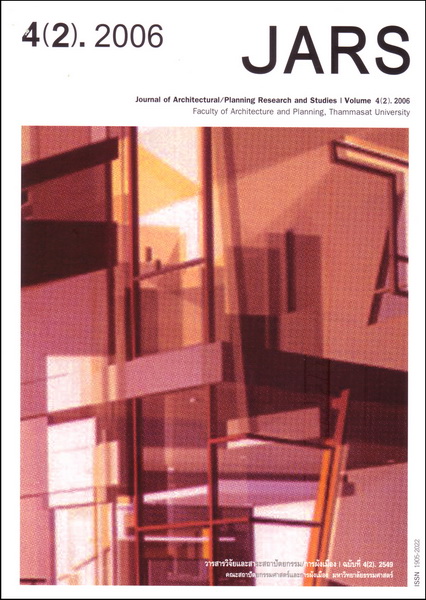Planning and Management toward Green and Clean University: Thammasat University, Rangsit Campus
Main Article Content
Abstract
One of the major problems facing Thammasat University, Rangsit campus is related to its planning
and management. In order to improve the current situation, the concept of ‘Planning and Management
guidelines toward Green and Clean University’ can provide guidelines to enhance a good environment on
campus. In addition, physical environment can influence human behavior. Good planning and management
also make a good quality of life and sustainable development. Therefore, planning and management guidelines
based on appropriate desire of users on Rangsit campus should be applied effectively.
The scope of this research focuses on the studies of planning and management theory and case
studies, surveys on university’s problems, opinions and effects, from 430 sampled users on campus through
questionnaire. The approaches regarding suitable planning and management toward green and clean university
for Thammasat University, Rangsit campus are under the following concepts:
1. To encourage the application of green and shady environment.
2. To administer with decreasing pollution plan in order to generate a better environment and
more safety.
3. To plan and manage toward clean and tidy environment.
4. To preserve energy and encourage the use of alternative resources.
5. To manage sustainable development effectively.
6. To strengthen a good quality of life.
7. To support public mind in environmental problems.
This research examines five successive aspects: 1) General spatial usage and initial opinions of
users, 2) Studying the suitability and sufficiency of planning and management on campus, 3) Studying
users’ responses in order to propose the guidelines under green and clean concept, 4) Studying users’
opinions regarding the proposed guidelines, and 5) Seeking more useful recommendations from users. The
researcher analyzes all data into four major categories for final guidelines: circulation network system,
linkage of activity areas, landscape and university’s energy preservation and environmental development
policies.
The research reveals that the university’s notable problems are: 1) University’s circulation networks (lanes between cars, bikes and pedestrians) are overlapped and lack clarity and continuity, 2) University’s planning system yields sector development similar to sector urban pattern, and there are no linkages between the various university’s sectors and activities on campus. In other words, the university does not have enough multipurpose areas for academic activities and activities between faculties and/or other universities, 3) The university lacks shady trees and has many untidy landscape areas, and 4) The university’s energy preservation and environmental development policies are not concrete with inadequate public understanding and being conducted under uninteresting programs.
Based on the research, conclusive improvement guidelines are suggested as follows:
1. Separating more clearly lanes between cars, bikes and pedestrians.
2. Using light transportation system in academic core area, in which cars and buses cannot enter. They must park in the parking lots surrounding the academic core area.
3. Expanding more continually bike lanes and covered walkways.
4. Allocating areas that are used for linkage of activities in residential area (dormitory area) and/ or in areas between residential area, library and academic area.
5. Providing more green areas and planting more shady trees in residential area and academic core area.
6. Developing tidy landscape areas to make them more beneficial with more amenities.
7. Improving efficiency of university’s energy preservation and environmental development policies and publicizing programs to all users.
8. Improving environmental programs in more interesting terms for users.
Downloads
Article Details

This work is licensed under a Creative Commons Attribution-NonCommercial-NoDerivatives 4.0 International License.
All material is licensed under the terms of the Creative Commons Attribution 4.0 International (CC-BY-NC-ND 4.0) License, unless otherwise stated. As such, authors are free to share, copy, and redistribute the material in any medium or format. The authors must give appropriate credit, provide a link to the license, and indicate if changes were made. The authors may do so in any reasonable manner, but not in any way that suggests the licensor endorses you or your use. The authors may not use the material for commercial purposes. If the authors remix, transform, or build upon the material, they may not distribute the modified material, unless permission is obtained from JARS. Final, accepted versions of the paper may be posted on third party repositories, provided appropriate acknowledgement to the original source is clearly noted.
References
รัชดาพร คณิตพันธ์ และคณะ. (2545). รายงานวิจัยการปรับปรุงผังแม่บทมหาวิทยาลัยธรรมศาสตร์ ศูนย์รังสิต. กรุงเทพฯ: คณะสถาปัตยกรรมศาสตร์ มหาวิทยาลัยธรรมศาสตร์.
King, R., & others. (2000). Green architecture: The sustainable built environment in the new millenium. Bangkok: Amarin Printing and Publishing.
Alexander, C., & others. (1997). The pattern language. New York: Oxford University Press.
ตรึงใจ บูรณสมภพ และคณะ. (2546). มหาวิทยาลัยเขียวสะอาด Green and Clean Campus รายงานวิจัยฉบับ สมบูรณ์ โดยทุนของสำนักนโยบายและแผนพลังงานกรุงเทพมหานคร. กรุงเทพฯ: อมรินทร์พริ้นท์ติ้งแอนด์พับลิชชิ่ง.
Gauzin – Muller, D. (2002). Sustainable architecture and urbanism: Concepts, technologies, example. Italy: Birkhauser.
ณัฏฐ พิชกรรม และคณะ. (2543). รายงานวิจัยฉบับสมบูรณ์ เรื่อง การศึกษาผลของพื้นที่สีเขียวที่มีต่อการลดอุณหภูมิอากาศในกรุงเทพมหานคร (Study on the Effect of Green Area to Reduce Air Temperature in Bangkok). กรุงเทพฯ.
มหาวิทยาลัยธรรมศาสตร์. (2549). นโยบายการบริหารงานในตำแหน่งอธิการบดีมหาวิทยาลัยธรรมศาสตร์. 9 สิงหาคม 2549, http://www.tu.ac.th/overview/admin/exec/25.surapon/policy/policy.htm.
Lynch, K. (1960). The image of the city. Massachusetts: The M.I.T. Press.
Givoni, B. (1998). Climate consideration in building and urban design. New York: Van Nostrand Reinhold.
สุนทร บุญญาธิการ. (2545). เทคนิคการออกแบบบ้านประหยัดพลังงานเพื่อคุณภาพชีวิตที่ดีกว่า (พิมพ์ครั้งที่ 2). กรุงเทพฯ: จีเอ็ม แม็ก มีเดีย.
Golany, G. S., Hanaki, K., & Koide, O. (1998). Japanese urban environment. Great Britain: Pergamon.
สุนทร บุญญาธิการ. (2547). กระบวนทัศน์ใหม่ของการออกแบบชุมชนเมือง. เมืองน่าอยู่และประหยัดพลังงาน. กรุงเทพฯ: สมาคมสถาปนิกชุมชนเมืองไทย สภาสถาปนิก สำนักงานนโยบายและแผนพลังงาน, 8-10.


